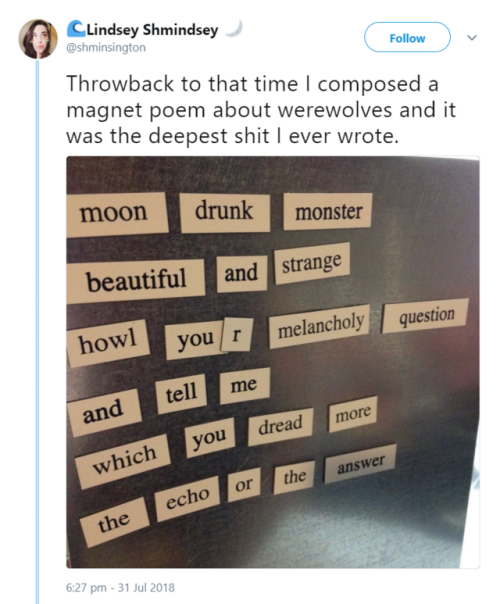WHEN THE SEMINAR IS ACTUALLY IN YOUR FIELD
WHEN THE SEMINAR IS ACTUALLY IN YOUR FIELD

credit: onepuffin
More Posts from Earthbending-sjw and Others
Gentrification
When you google the definition, it says: “the process of renewal and rebuilding accompanying the influx of middle-class or affluent people into deteriorating areas that often displaces poorer residents.”

The definition should say: “the process of dramatic change and remodel accompanying the influx of white middle-class or white affluent people who ransack the rich history and spirit of neighborhoods, which displaces longtime residents and business owners of color, in favor of high-priced homes, eateries, and other establishments that are homogenous to whiteness while renaming the area, as well as stabilizing rent hikes and high property values to keep former residents of color out.”

Happy International Women’s Day to all the fabulous Trek fans who believe a better and more equal future is possible.
Largest Batch of Earth-size, Habitable Zone Planets
Our Spitzer Space Telescope has revealed the first known system of seven Earth-size planets around a single star. Three of these planets are firmly located in an area called the habitable zone, where liquid water is most likely to exist on a rocky planet.

This exoplanet system is called TRAPPIST-1, named for The Transiting Planets and Planetesimals Small Telescope (TRAPPIST) in Chile. In May 2016, researchers using TRAPPIST announced they had discovered three planets in the system.

Assisted by several ground-based telescopes, Spitzer confirmed the existence of two of these planets and discovered five additional ones, increasing the number of known planets in the system to seven.

This is the FIRST time three terrestrial planets have been found in the habitable zone of a star, and this is the FIRST time we have been able to measure both the masses and the radius for habitable zone Earth-sized planets.
All of these seven planets could have liquid water, key to life as we know it, under the right atmospheric conditions, but the chances are highest with the three in the habitable zone.

At about 40 light-years (235 trillion miles) from Earth, the system of planets is relatively close to us, in the constellation Aquarius. Because they are located outside of our solar system, these planets are scientifically known as exoplanets. To clarify, exoplanets are planets outside our solar system that orbit a sun-like star.

In this animation, you can see the planets orbiting the star, with the green area representing the famous habitable zone, defined as the range of distance to the star for which an Earth-like planet is the most likely to harbor abundant liquid water on its surface. Planets e, f and g fall in the habitable zone of the star.
Using Spitzer data, the team precisely measured the sizes of the seven planets and developed first estimates of the masses of six of them. The mass of the seventh and farthest exoplanet has not yet been estimated.

For comparison…if our sun was the size of a basketball, the TRAPPIST-1 star would be the size of a golf ball.
Based on their densities, all of the TRAPPIST-1 planets are likely to be rocky. Further observations will not only help determine whether they are rich in water, but also possibly reveal whether any could have liquid water on their surfaces.
The sun at the center of this system is classified as an ultra-cool dwarf and is so cool that liquid water could survive on planets orbiting very close to it, closer than is possible on planets in our solar system. All seven of the TRAPPIST-1 planetary orbits are closer to their host star than Mercury is to our sun.

The planets also are very close to each other. How close? Well, if a person was standing on one of the planet’s surface, they could gaze up and potentially see geological features or clouds of neighboring worlds, which would sometimes appear larger than the moon in Earth’s sky.

The planets may also be tidally-locked to their star, which means the same side of the planet is always facing the star, therefore each side is either perpetual day or night. This could mean they have weather patterns totally unlike those on Earth, such as strong wind blowing from the day side to the night side, and extreme temperature changes.

Because most TRAPPIST-1 planets are likely to be rocky, and they are very close to one another, scientists view the Galilean moons of Jupiter – lo, Europa, Callisto, Ganymede – as good comparisons in our solar system. All of these moons are also tidally locked to Jupiter. The TRAPPIST-1 star is only slightly wider than Jupiter, yet much warmer.
How Did the Spitzer Space Telescope Detect this System?
Spitzer, an infrared telescope that trails Earth as it orbits the sun, was well-suited for studying TRAPPIST-1 because the star glows brightest in infrared light, whose wavelengths are longer than the eye can see. Spitzer is uniquely positioned in its orbit to observe enough crossing (aka transits) of the planets in front of the host star to reveal the complex architecture of the system.

Every time a planet passes by, or transits, a star, it blocks out some light. Spitzer measured the dips in light and based on how big the dip, you can determine the size of the planet. The timing of the transits tells you how long it takes for the planet to orbit the star.

The TRAPPIST-1 system provides one of the best opportunities in the next decade to study the atmospheres around Earth-size planets. Spitzer, Hubble and Kepler will help astronomers plan for follow-up studies using our upcoming James Webb Space Telescope, launching in 2018. With much greater sensitivity, Webb will be able to detect the chemical fingerprints of water, methane, oxygen, ozone and other components of a planet’s atmosphere.
At 40 light-years away, humans won’t be visiting this system in person anytime soon…that said…this poster can help us imagine what it would be like:

Make sure to follow us on Tumblr for your regular dose of space: http://nasa.tumblr.com


This is both amazing and profoundly irritating - the exact writing equivalent of that thing artists do - you know, how they’ll mess up anything that’s on expensive paper and planned in every single detail but get them doodling during a boring lesson and suddenly they’re Michel-bloody-angelo.
everyone here hates when their posts blow up yet no one fucking hesitates to reblog already popular posts. no one shows that kindness and it's wonderful. a mutual understanding that op dug their own grave by being a top notch clown and that's their problem, not yours










The Nightly Show, December 10, 2015

(Queen) Nakia at the Oscars
“It takes courage to grow up and become who you really are.”
— E.E. Cummings

I should’ve posted this yesterday, whoops. 17/3/2016 || Day 1/100 of productivity I finished my final exams for Winter Quarter on Wednesday; I’m officially on spring break, but that doesn’t mean I can’t be productive. I did some reading and planning for Monday’s UW Math Day planetarium show. Also, I finally organized my desk!
-
 zaorazor liked this · 7 years ago
zaorazor liked this · 7 years ago -
 cantyoufindme liked this · 7 years ago
cantyoufindme liked this · 7 years ago -
 jabrow26-blog liked this · 7 years ago
jabrow26-blog liked this · 7 years ago -
 methlabmoonpie reblogged this · 7 years ago
methlabmoonpie reblogged this · 7 years ago -
 whereismysupasuit reblogged this · 8 years ago
whereismysupasuit reblogged this · 8 years ago -
 wildpreciouslife reblogged this · 8 years ago
wildpreciouslife reblogged this · 8 years ago -
 trip-tucker liked this · 8 years ago
trip-tucker liked this · 8 years ago -
 spirit-swordsman liked this · 8 years ago
spirit-swordsman liked this · 8 years ago -
 pink-dark-boye liked this · 8 years ago
pink-dark-boye liked this · 8 years ago -
 chole-frijole liked this · 8 years ago
chole-frijole liked this · 8 years ago -
 firstandfinalfrontier liked this · 8 years ago
firstandfinalfrontier liked this · 8 years ago -
 insidiousnachos liked this · 8 years ago
insidiousnachos liked this · 8 years ago -
 bookslegosnotherstuff liked this · 8 years ago
bookslegosnotherstuff liked this · 8 years ago -
 mtgrapbattles liked this · 8 years ago
mtgrapbattles liked this · 8 years ago -
 usmellalot liked this · 8 years ago
usmellalot liked this · 8 years ago -
 femwizard reblogged this · 8 years ago
femwizard reblogged this · 8 years ago -
 geostatonary liked this · 8 years ago
geostatonary liked this · 8 years ago -
 victoriancuddler reblogged this · 8 years ago
victoriancuddler reblogged this · 8 years ago -
 victoriancuddler liked this · 8 years ago
victoriancuddler liked this · 8 years ago -
 magikyle liked this · 8 years ago
magikyle liked this · 8 years ago -
 haaas12-blog liked this · 8 years ago
haaas12-blog liked this · 8 years ago -
 pineappleweeb reblogged this · 8 years ago
pineappleweeb reblogged this · 8 years ago -
 spacejew liked this · 8 years ago
spacejew liked this · 8 years ago -
 gentlemangonerogue liked this · 8 years ago
gentlemangonerogue liked this · 8 years ago -
 hotdogcephalopod reblogged this · 8 years ago
hotdogcephalopod reblogged this · 8 years ago -
 kresh-the-buttbraided liked this · 8 years ago
kresh-the-buttbraided liked this · 8 years ago -
 bethany69esda liked this · 8 years ago
bethany69esda liked this · 8 years ago -
 pumpkinofthedale reblogged this · 8 years ago
pumpkinofthedale reblogged this · 8 years ago -
 pumpkinofthedale liked this · 8 years ago
pumpkinofthedale liked this · 8 years ago -
 bird-cannibalism liked this · 8 years ago
bird-cannibalism liked this · 8 years ago -
 prophet-of-sass liked this · 8 years ago
prophet-of-sass liked this · 8 years ago -
 rade-blunner liked this · 8 years ago
rade-blunner liked this · 8 years ago -
 ezurad liked this · 8 years ago
ezurad liked this · 8 years ago -
 bayloooona reblogged this · 8 years ago
bayloooona reblogged this · 8 years ago -
 geralf-of-thraben reblogged this · 8 years ago
geralf-of-thraben reblogged this · 8 years ago -
 geralf-of-thraben liked this · 8 years ago
geralf-of-thraben liked this · 8 years ago -
 blueacedia liked this · 8 years ago
blueacedia liked this · 8 years ago -
 lean-coq-official liked this · 8 years ago
lean-coq-official liked this · 8 years ago -
 berryokay liked this · 8 years ago
berryokay liked this · 8 years ago -
 caustic--acid liked this · 8 years ago
caustic--acid liked this · 8 years ago -
 chandra-nalaar reblogged this · 8 years ago
chandra-nalaar reblogged this · 8 years ago -
 deadciv liked this · 8 years ago
deadciv liked this · 8 years ago -
 dimir-charmer reblogged this · 8 years ago
dimir-charmer reblogged this · 8 years ago -
 historybunny reblogged this · 8 years ago
historybunny reblogged this · 8 years ago
Climate Justice Organizer | Dark Academia Enthusiast | Writer
151 posts